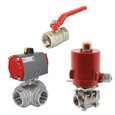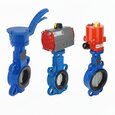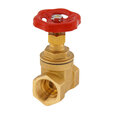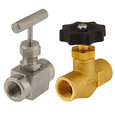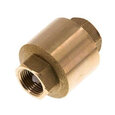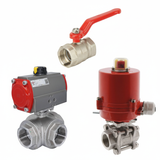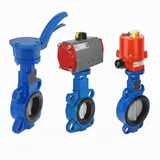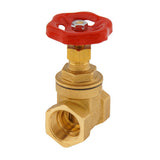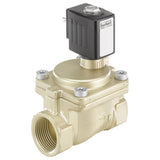Cv Calculator
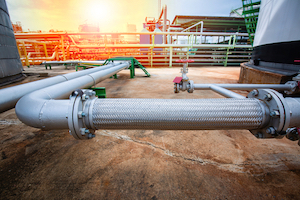
Figure 1: Pipes at a oil refinery
A valve’s flow coefficient (Cv) measures the flow of water through the valve at 60 °F in U.S. gallons per minute (GPM). Pipefitters, engineers, and manufacturers use Cv to determine the appropriate size of valves for the specific volume of fluid that flows through them. Choosing a valve with a suitable flow coefficient ensures proper flow control, prevents leakage and maintains the desired process conditions.
Cv-value calculator liquids & gasses
- Liquids: Fill in a value for the inlet pressure, the outlet pressure, and the minimum required flow rate. Click calculate, and the Cv value and Kv value will be calculated. Choose a valve with a Cv-value equal to or higher than the calculated value.
- Gas: Choose a gas type and the inlet temperature. Choose the inlet pressure, the outlet pressure, the required flow rate and click calculate. Choose a valve with an equal or higher Cv-value to achieve the desired flow rate. The N in the flow rate stands for normal conditions (atmospheric pressure and 0 degrees Celsius).
Table of contents
- What is flow coefficient
- Valve flow coefficient variables
- Cv calculator
- Why is Cv important
- Difference between Cv value & Kv flow coefficients
- Cv to GPM conversion
- FAQs
View our online selection of valves!
What is flow coefficient
This article explores the definition and the importance of choosing a valve with the correct Cv value. Read our article on the Kv calculator to know more about the metric flow factor, which is equivalent to Cv.
Valve flow coefficient measures the rate at which fluid (liquid or gas) can pass through a valve. The Cv value is the flow coefficient in the imperial system. It is a valuable tool for selecting the appropriate sized valve, ensuring that all fluids can flow through at the desired pressure. The Cv value is listed in the valve’s product description or specifications label. For example, if a particular valve has a valve flow coefficient of 2, it will allow 2 GPM of water through the valve with a pressure drop of 1 PSI. To allow 3 GPM of water through, choose a different valve with a flow coefficient of 3. The higher the valve Cv rating, the greater the flow capacity of the valve.
Valve flow coefficient variables
When calculating the valve flow coefficient, it is crucial to consider various factors such as the fluid's properties, the valve's characteristics, and the desired flow rate.
Specific gravity
A fluid’s specific gravity affects its density, which in turn affects its flow rate. Specific gravity is the ratio of a fluid's density to the density of water at a specific temperature. It is a dimensionless unit that compares the relative densities of different fluids. Water has a specific gravity of 1.00 at 60 °F.
Flow rate
The flow rate (Q) measures the amount of fluid passing through the valve at any given time. It is commonly expressed in gallons per minute (GPM). To determine the flow rate, divide the volume of fluid passing through the valve by the time it takes for said volume to pass through. For example, if 50 gallons of water takes 7 minutes to run through the valve, the flow rate is 7.1 GPM.
Pressure drop
The best way to calculate pressure drop is through standard graphs. The user needs to know the pipe type, inner diameter, and flow rate. Using these values, locate the corresponding pressure drop on the chart (usually represented in psi) corresponding to these values. Alternately, calculate the pressure drop using the difference between upstream and downstream fluid pressure.
Cv flow calculator
The Cv value is an important factor in determining the correct valve size for a specific application. To calculate the Cv for a valve, the following parameters are required:
- Q: Desired flow rate
- dp: Pressure differential
- SG: Specific gravity
Once the Cv value is calculated, it is recommended to choose a valve with a Cv value slightly higher than the calculated value. This ensures that the desired flow rate is achieved and provides a safety margin for potential changes in pressure or flow rate. In some cases, the value is predetermined and you can calculate the flow rate suitable for that valve by working the formula backwards from to the known Cv value
Also, the expressions for Cv are different for liquids and gasses. This is because the physical properties and behavior of liquids and gasses are different.
- Liquids are nearly incompressible, while gasses are highly compressible. The pressure drop across a pipe carrying a liquid is different from that of a gas due to the difference in compressibility.
- Liquids have a higher viscosity than gases, which affects their flow rate.
The flow rate equations for liquids and gases take into account these differences and provide a more accurate representation of the flow rate for each fluid type.
Cv calculator for liquids
For liquids,
- Q: Flow rate in gallons per minute (GPM) at 60 °F
- dp: Pressure differential [psi]
- SG: Specific gravity of the liquid
The Cv value is the flow rate of water in U.S. gallons per minute (GPM) at a temperature of 60 𐩑F with a pressure drop of 1 psi across the valve. For example, a valve with a Cv of 12 will pass 12 GPM of fluid at 1 psi pressure drop across the valve at 60 𐩑F.
The larger the valve opening, the greater the Cv value. As a valve is opened from its fully closed position, the Cv value increases gradually from zero until reaching its maximum value at the fully opened state (100% open valve Cv).
Example Cv calculation for water
To calculate the Cv value of a valve for a water flow of 18 GPM (gallons per minute) with a differential pressure of 9 psi,
- Q = 18 GPM
- SG = 1
- dp = 9 psi
Hence, the required Cv value is 6. Use this value to choose an appropriate size for the valve, as discussed later in this article. The equation can also be used to calculate the flow rate, given Cv and pressure drop values.
Cv calculator for gasses
Gas flow through a valve can transition between subcritical and supercritical flow.
- Subcritical: The downstream pressure (P2) is more than half of the upstream pressure (P1). Therefore, changes in downstream pressure can affect the flow rate. This type of flow is also known as choked flow.
- Supercritical: The downstream pressure is less than half of the upstream pressure. Changes in the downstream pressure do not affect the flow rate.
| Subcritical equation | |
| Supercritical equation |
- Cv: Flow coefficient of valve
- G: Specific gravity of gas at flowing conditions
- P1: Upstream (inlet) pressure in psia (psia is absolute pressure)
-
P2: Downstream (outlet) pressure in psia
- psia = psig +14.7
- Psig is the pound per square inch gauge. It is a pressure unit relative to the atmospheric pressure.
- Q: Volumetric flow rate, SCFH
-
T: Absolute temperature on the Rankine Scale
- 𐩑R = 𐩑F + 459.67
- 𐩑R = (𐩑C * 1.8) + 491.67
Example Cv calculation for gasses
Calculate the Cv value of a gas with specific gravity 0.966, inlet pressure 100 psig, outlet pressure 95 psig, flow rate Q equal to 15000 SCFH at a temperature of 70 𐩑F.
Solution
- G = 0.966
- p1= 100 psig = 100 +14.7 psia = 114.7 psia
- p2= 95 psig = 95+14.7 psia = 109.7 psia
- Δp = 5 psia
- T= 70 𐩑F = 70 + 460 = 530 𐩑R
Half of the input pressure is less than the output pressure, therefore
Therefore, the value of Cv = 11.3.
Why is Cv important
Determining the Cv value helps in selecting the right-sized valve for an application. If the Cv value of a valve is incorrect, it can result in poor performance of the valve within a day or two. This can result in several problems, such as: :
- Control loss: The valve may not be able to open or close fully, leading to pressure drops or over-pressurization. This can cause damage to the system and potentially lead to leaks or other safety hazards.
- Reduced efficiency: Too big or too small valves can lead to increased energy consumption, making the system less efficient.
- Shortened lifespan: Over time, the valve may experience increased wear and tear, which can shorten its lifespan and lead to the need for more frequent maintenance and replacement.
- Inconsistency in operation: The valve may not be able to maintain a consistent flow rate, leading to fluctuations in the system's performance.
- Cavitation: If the valve is undersized for the process, significant pressure drops across the valve may lead to cavitation and flashing.
- Water hammer: An oversized valve can result in significant throttling and water hammer.
Difference between Cv value & Kv flow coefficients
Cv and Kv are used to measure fluid flow rate through a valve. However, the two have several key differences:
- Units: Cv is expressed in US gallons per minute (gpm), while Kv is expressed in m³/hr.
- Pressure drop: Cv is based on one psi (pound per square inch) pressure drop, while Kv is based on a 1 bar pressure drop. This means that Cv and Kv are not directly comparable and must be converted when used in different systems with different pressure drop units.
- Application: Cv is primarily used in the US and Canada, while Kv is widely used in Europe and other parts of the world.
Conversion formulae for Cv and Kv
It is possible to convert between the flow coefficients Cv and Kv.
Kv = 0.857 * Cv
Cv = 1.165 * Kv
Cv to GPM conversion
Why convert Cv to GPM
GPM (gallons per minute) is a standard unit for measuring fluid flow in a system. It represents the volume of liquid that passes a point in the system within one minute. Cv to GPM conversion is necessary in various industries, including HVAC, plumbing, and process engineering for multiple reasons:
- System design: Engineers design systems using GPM to specify flow requirements, but valve manufacturers typically provide valve characteristics using Cv values.
- Valve selection: When selecting a valve for a specific application, it's crucial to ensure it can handle the required flow rate (GPM) under the given pressure conditions.
- Performance prediction: Converting between Cv and GPM allows engineers to predict how a valve will perform under different flow and pressure conditions.
- Component replacement: When replacing valves or other components, converting Cv to GPM ensures compatibility with existing system specifications, preventing mismatches and operational issues.
- Maintenance planning: Understanding flow rates through conversions helps predict maintenance needs, making it possible to schedule interventions before problems arise, reducing downtime and costs.
Cv to GPM calculator
The Cv to GPM conversion formula is essential for understanding the relationship between the flow coefficient and the flow rate. For an incompressible fluid:
Where:
- GPM: Flow rate in gallons per minute
- Cv: Valve flow coefficient
- ΔP: Pressure drop across the valve (psi)
- G: Specific gravity of the fluid
Consider a control valve with Cv = 25, operating with a 10 psi pressure drop, controlling a liquid with SG = 0.9.
In this case, the flow rate is 83.33 gallons per minute (GPM).
FAQs
What is flow coefficient Cv for valves?
The flow coefficient, also known as the Cv value, is the flow rate of water in U.S. gallons per minute (GPM) at a temperature of 60 𐩑F with a pressure drop of 1 psi across the valve.
Why is it important to convert GPM to Cv for valve selection?
Converting GPM to Cv ensures the valve can handle the required flow rate under specific pressure conditions, leading to accurate valve sizing and optimal system performance.




